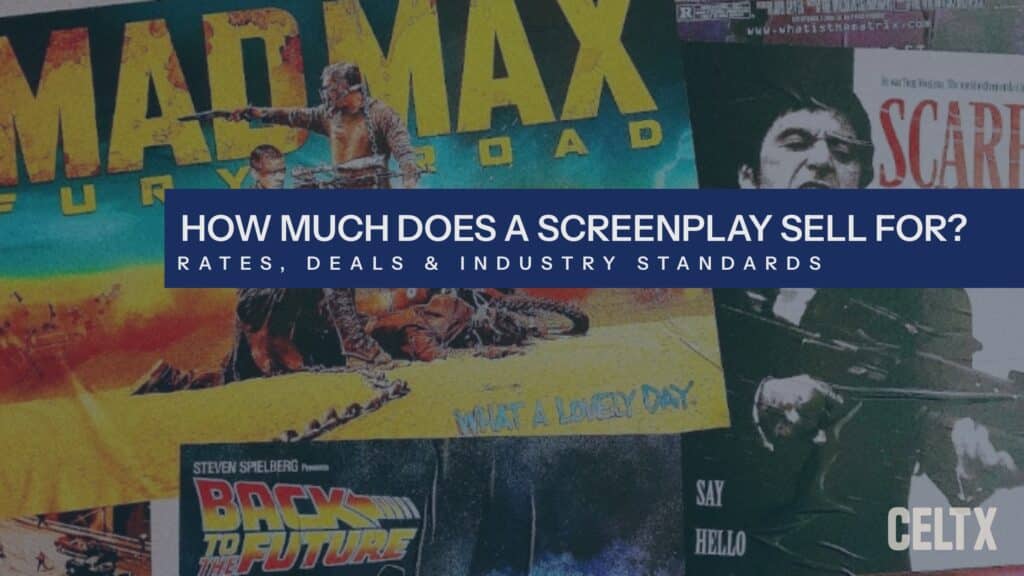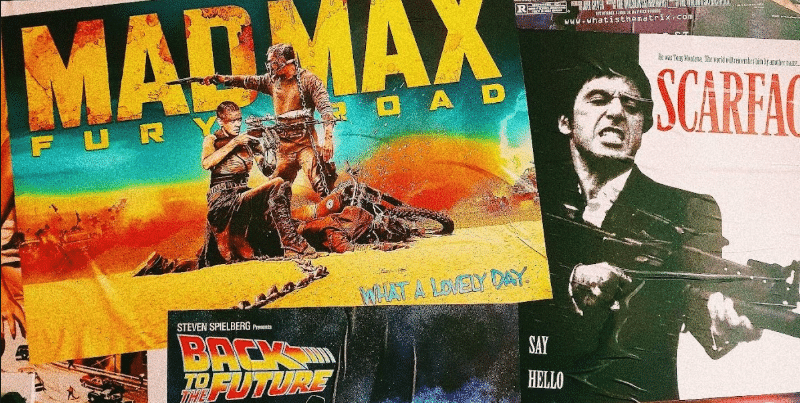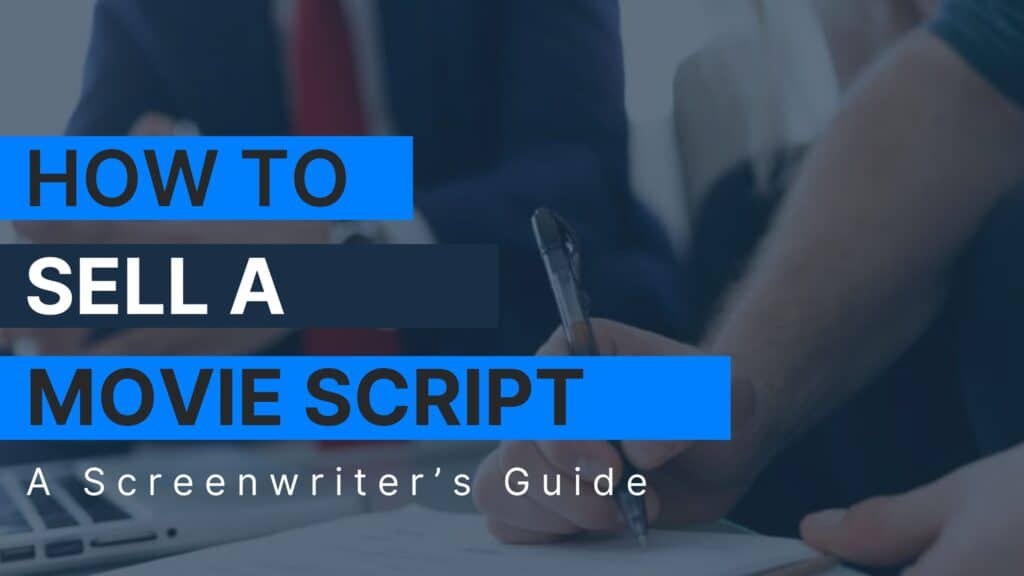
If you’ve ever asked yourself, “how much does a screenplay sell for?”, or, “how much does a screenwriter actually get paid?”, you’re not alone. In a sea of spec scripts, treatments, pilots, features, and streaming series, the numbers can feel like a myth wrapped in a Hollywood cliché.
But fear not, because we’re here to help! In today’s blog, we’ll cut through the fog and give you real-world benchmarks, union minimums, market realities, and everything in between (you lucky things!).
Something to keep in mind: while our blog references US rates and conditions (particularly those of the Writers Guild of America or WGA), the lessons translate globally, especially when you’re negotiating from the UK or elsewhere.
So, without further ado… let’s dive in!

Table of Contents
- The Big Question
- The WGA Minimums (The Floor)
- The Spec Sale Reality (The Ceiling)
- Feature vs. Pilot vs. Streaming Series
- The 2024 Market Trends
- The Value of the Writer
- FAQs
- Conclusion
The Big Question
What does a screenplay actually sell for? The short answer is this: there’s no single number. Whereas the long answer is, it depends on multiple variables.
Here are a few of the major factors we need to consider when pricing a screenplay:
- The Budget of the Production: Are we talking a $1 million indie film or a $100 million studio blockbuster?
- Original vs. Non-Original Screenplay: Was it born in your head, or adapted from other material?
- Treatment, Rewrite, Polish, Spec Sale: Are you delivering a full draft from scratch, or being hired to polish/rewrite something?
- Format: Is your script a feature film, television pilot, or streaming series?
- Writer’s Leverage and Track Record: Are you an emerging writer or someone with credits and representation?
- Union vs. Non-Union: Are you covered by WGA minimums, or negotiating outside of that structure?
- Backend and Residuals: Does the deal include bonuses tied to box-office or streaming success?
By the end of this blog, you should have a much clearer sense of the ‘floor’ (what you should at least aim for), the ‘ceiling’ (how high things can go), and the real market terrain in between.

Okay, so think of value as a sliding scale rather than a fixed price. On one end lies the guaranteed minimums set by the WGA (for union projects). On the other end lies what speculative scripts, hot writer deals, mega-budget studio hires can command. Your job is to understand where you fall on that spectrum and negotiate accordingly.
The WGA Minimums (The Floor)
Let’s get into the numbers.
If your project falls under the jurisdiction of the Writers Guild of America, then the WGA Minimum Basic Agreement (MBA) sets a legal baseline for what you must be paid. These numbers constitute the ‘floor’ which is your starting point. Anything less than this (for a covered project) means you’re short-changing yourself.
Here are some up-to-date figures for the US theatrical feature space from 2023 (for ease, we have rounded the numbers. The actual contract will have the precise numbers)
| Budget Tier | Original Screenplay (with Treatment) | Original Screenplay (w/o Treatment) | Non-Original Screenplay (with Treatment) | Non-Original Screenplay (w/o Treatment) |
| Low Budget (under ~$5 million) | ~$90,900 | ~$61,000 | ~$79,500 | ~$49,700 |
| High Budget (~$5 million or more) | ~$170,600 | ~$125,000 | ~$147,900 | ~$102,300 |
And to emphasize… these are minimums. Many deals (especially non-union) pay less, and many high-end deals pay much more.

In 2023, an update was added in regard to 2nd-step deals for flat hires at or below 200% minimums. Also, most minimums rose by 5%, with further increases on the way.
Let’s break this down further:
| Type | Low Budget Feature | High Budget Feature |
| Original Screenplay (with Treatment) | ~$90k | ~$170k |
| Original Screenplay (w/o Treatment) | ~$61k | ~$125k |
| Non-Original Screenplay (with Treatment) | ~$79.5k | ~$147.9k |
| Non-Original Screenplay (w/o Treatment) | ~$49.7k | ~$102.3k |
| Story/Treatment Only | ~$30k | ~$45-60k |
| Rewrite | ~$30+ | ~$45k+ |
| Polish | ~$15k | (Higher, but varies) |
The bottom line is, if your deal is covered by WGA, aim for at least these numbers. They’re your baseline. If you get significantly less (and the project is covered), you should question the contract.
The Spec Sale Reality (The Ceiling)
Let’s zoom out to the ‘ceiling’, the deals that sit way above the minimums: spec sales, multi-step hiring, big studio or streaming engagements. While these aren’t typical for first-time writers, knowing their magnitude gives you perspective.
Per the WGA’s own Screen Compensation Guide:
- The median guaranteed compensation for a one-step first draft deal (across all companies) is around $450,000. The maximum reported has been up to $2.25m.
- For writers with no credits, the median was ~$300k. For writers with two or more credits, it was ~$600k, the maximum at $2.25m.
- For rewrites, the median was ~$200k, the maximum up to ~$1m
Additionally, spec script sales can go far beyond this. It just goes to show how budget, studio scale, and leverage can expand deal sizes way above the union minimums.

Feature vs. Pilot vs. Streaming Series
So now we’ve established the floor and ceiling for theatrical feature screenplays, it’s time to break out the different formats. You see, compensation varies depending on whether you’re writing a feature film, TV pilot, or streaming series.
Let’s focus on each in turn:
Feature Films
As we’ve already seen, feature films have a fairly well-established WGA scale (depending on budget). For non-union deals, especially internationally (like UK or smaller markets), the numbers can be lower. However, the same principles of budget and leverage apply.
TV Pilots and Episodic Series
Writing for television introduces some new dynamics.
A pilot script can be very lucrative because it includes option/purchase of rights plus the possibility of series pickups and subsequent episodes. Writers may also receive series commitments, staff positions, episode fees, and backend compensation (residuals/royalties) for episodic shows.
The WGA minimums for television vary widely based on runtime, network vs. cable vs. streaming, existing staff vs. freelance episodes. For example, a TV staff writer minimum for a drama might be around $6k a week under certain conditions.
Streaming Series/Platforms
Streaming has completely turned the traditional model on its head, which has created some fantastic opportunities, as well as some complexities.
With streaming comes larger budgets, which means even larger deals! For example, a feature-length streaming project with a budget of $30m or more is subject to an elevated WGA minimum (~18% increase) and improved residuals.
This is mostly for the giant streaming platforms; however, the lesser-known ones may pay less or structure compensation differently (with fewer episodes and shorter seasons).
And because the streaming world is global and non-theatrical, many deals may be outside the strict WGA minimums (especially for non-US productions). This can both reduce guarantee and increase variability.
Let’s look at how each of these three formats compare side-by-side:
| Format | Typical Compensation | Key Factors |
| Feature film | From WGA minimum (~$60k to $170k) upward. | Budget size, original vs. non-original, writer’s leverage. |
| TV pilot/single episode | Variable ($100k+ is common) | Platform, staff vs. freelance, episode order. |
| Streaming series | Wide range (Hundreds to millions of dollars) | Budget, global rights, fellow writers, backend. |
The 2024 Market Trends
What’s changed recently? Well, especially with the rise of streaming, the globalization of content, and the shifting economics of film and television, here are some of the major trends for 2024 and beyond:
Streaming and Global Rights
Streaming platforms have increased their appetite for original content, which means more opportunities, but also more competition and often more complex deals (territories, rights, residuals). For writers, this means:
- Larger up-front fees for big platform projects.
- Increased importance of backend/residual participation; the longer your work is leveraged (through views, international distribution, etc.), the more “passive income” you can earn.
- More mini-rooms, shorter seasons, and fewer episodes per show. This reduces total episode fees, even if per-episode rates remain strong.

Staff Writer Shortages and Leverage
In the TV world, especially post-writers-strike, the number of days in writers’ rooms is shrinking; competition is fierce; the size of rooms is smaller. This can affect pay structure, job length, and leveraging power.
And that’s not all the 2023 writers strike affected. Variety has more right here.
Union Minimums Are Rising
The 2023-2026 WGA agreement includes scheduled increases: 5% on Sept 25, 2023, then around 4% on May 2, 2024, and 3.5% on May 2, 2025. That means your “floor number” is moving upwards. It’s good news for new writers!
Non-Union and International Markets
With global content growth, many projects are produced outside US union districts. That means pay may be lower, but the flip side is more opportunity, especially for international writers or co-productions. For UK-based screenwriters, tailoring contracts for non-US markets is increasingly relevant.
Quality Over Format
Finally: the script itself matters more than ever. Budget, platform, trailer buzz all matter, yes, but buyers are still investing in writers with strong voice, proof of craft, and a track record (or at least a great sample). The leverage still tilts toward quality.
And for more on how the industry has changed in recent years, check out this awesome article from The Ankler for the load down.
The Value of the Writer
Now’s the time to talk about you. Because no matter how big the studio or platform is, it’s the writer’s value, leverage, and network that often determine how far beyond the floor you go.
Leverage and Track Record
A writer with no credits will likely negotiate closer to minimums or mid-market deals; per WGA data: median ~$300K for one-step deals for writers with no screen credits.
A writer with one or more credits can push higher: per WGA, writers with two or more credits had median ~$600K in one-step deals, with ceilings into the multi-million.
Having a strong agent/manager, producing partner, or script champion in the studio/streamer ecosystem significantly improves your leverage.

Format and Ownership
Writers who sell original spec scripts often get better deals (more premium) because they’re offering something unique.
Writers who adapt or rewrite existing material may have less leverage unless the property is hot.
Writers who retain or negotiate ownership/back-end participation (e.g., profit participation, residuals, credits) often earn far more over time.
Professionalism and Packaging
Industry players pay attention to whether you deliver on time, professionally formatted, and story ready. A clean script, properly registered, formatted to industry standard, makes negotiation easier.
FAQs
For a low-budget feature (under ~$5 million), the WGA minimum for an original screenplay with treatment is about $90,900 (2023 figure) and about $61,000 without treatment.
For high-budget features ($5 million or more), original screenplay with treatment is about $170,600, without treatment around $125,000.
WGA minimum refers to the contractual minimum payments set by the WGA MBA for projects covered by that union contract—they’re the legal “floor” for union jobs.
A spec sale means the writer sells a script on spec (i.e., they wrote it without a guaranteed deal beforehand) and then a buyer purchases it. Spec sales often pay well above the WGA minimums (the “ceiling”) and involve higher leverage, studio bidding, or hot market properties.
It varies widely based on network vs streaming, single-camera vs multi-camera, writer’s history, and whether there’s an option/purchase + series commitment. While there’s no single “minimum” number easily found (especially outside union projects), expect six-figure up-front fees for good pilots, and more if you negotiate backend participation. The WGA minimums for staff writer or story/teleplay episodes provide a baseline (e.g., ~$5,935/week staff writer in some cases) but pilot deals often exceed that.
“Backend” (also called participation, residuals, profit‐participation) refers to compensation after the upfront purchase fee. It’s a portion of the revenue, profit, streaming views, box-office, or licensing that you are contractually entitled to. For example: if your script becomes a hit and generates significant revenue, you might receive additional payments or bonuses. For a savvy writer, backend can ultimately be more lucrative than the upfront fee—but it also comes with risk (remote chance of large payoff).
Conclusion
Let’s bring it all home:
Your script is your greatest asset. It holds potential value determined by budget, format, market, your track record, and your negotiation. Knowing the numbers should empower you in your pursuit of success.
Yes: the numbers are real, but so is the craft. Never lose sight of the fact that quality matters. A beautifully formatted, tightly written, emotionally resonant script stands a far better chance of commanding a strong deal than a sloppy one.
So, hone your voice. Register your work. Polish your format. Write a killer logline. Use Celtx to give your script that professional edge. Because when the right buyer reads it, you want them to see potential, not just a good idea.
Ready to write a script worth selling? Start for free today.
Up Next:

How to Sell a Movie Script in 2025: A Screenwriter’s Guide
Once you know what a screenplay can sell for, learn how to get yours in front of the right people. From pitching to networking, here’s how to take the next step toward selling your script.
